AUTHORS
CATEGORIES
- Airsoft (2)
- Austin (8)
- Books (9)
- Cooking For Engineers (20)
- Credit Cards (2)
- Current Events (9)
- Deals (4)
- Dining (37)
- Fanpop (4)
- Food (808)
- Games (5)
- Hairy (6)
- Kitchen Gear (7)
- Life (24)
- Miscellaneous (6)
- Movies (15)
- Orthogonal Thought (6)
- Personal Computers (10)
- Photography (158)
- Rant (9)
- Ruby on Rails (2)
- San Francisco (5)
- Soap Making (5)
- Television (11)
- Texas (1)
- Things We Like (11)
- Travel (11)
- Wear or Not (1)
- Web 2.0 (9)
- What I Ate (861)
- Wikipedia (5)
- Windows 10 (3)
- Windows Mobile (1)
- WordPress (1)
ARCHIVE
- September 2018 (1)
- September 2017 (1)
- March 2017 (1)
- September 2016 (2)
- August 2016 (2)
- September 2015 (1)
- November 2014 (1)
- August 2014 (1)
- January 2014 (1)
- September 2013 (1)
- December 2012 (1)
- November 2012 (3)
- September 2012 (1)
- August 2012 (2)
- June 2012 (2)
- February 2012 (1)
- January 2012 (4)
- December 2011 (4)
- October 2011 (2)
- September 2011 (5)
- August 2011 (1)
- July 2011 (2)
- April 2011 (2)
- February 2011 (5)
- January 2011 (12)
- December 2010 (37)
- November 2010 (30)
- October 2010 (25)
- September 2010 (30)
- August 2010 (32)
- July 2010 (34)
- June 2010 (31)
- May 2010 (35)
- April 2010 (35)
- March 2010 (33)
- February 2010 (34)
- January 2010 (33)
- December 2009 (30)
- November 2009 (31)
- October 2009 (30)
- September 2009 (31)
- August 2009 (34)
- July 2009 (34)
- June 2009 (34)
- May 2009 (33)
- April 2009 (32)
- March 2009 (42)
- February 2009 (38)
- January 2009 (57)
- December 2008 (40)
- November 2008 (30)
- October 2008 (33)
- September 2008 (22)
- August 2008 (5)
- July 2008 (5)
- June 2008 (11)
- May 2008 (13)
- April 2008 (10)
- March 2008 (29)
- February 2008 (18)
- January 2008 (28)
- December 2007 (1)
- November 2007 (4)
- October 2007 (5)
- September 2007 (10)
- August 2007 (14)
- July 2007 (10)
- June 2007 (9)
- May 2007 (21)
- April 2007 (21)
What I Ate: July 7, 2009 (Coyote Creek Farm)
Posted 7 July, 2009 at 11:39pm by Michael Chu(Filed under: Food, What I Ate)
Dinner: Technically, I didn't eat at Coyote Creek Farm, but my dinner was heavily indebted to it. This dinner tale begins at 6:00am when I got up to drive out to Elgin, Texas to visit Jeremiah Cunningham at his farm: Coyote Creek Farm. My persistent readers will remember that I've been raving about the eggs from Coyote Creek (see the last paragraph of this post), so we had to see for ourselves. After corresponding with Jeremiah via email, we arranged for Tina and me to arrive at the farm at 8:00am.
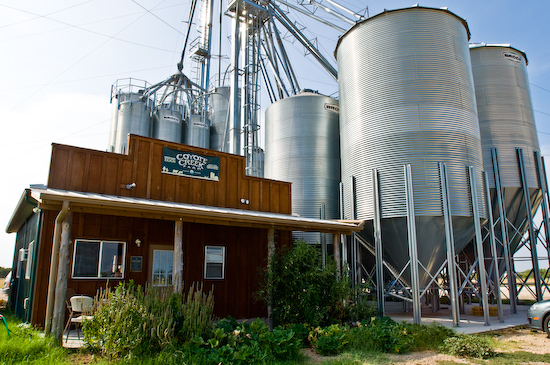
It turns out Jeremiah is doing a lot more than producing incredible eggs. He's trying to encourage sustainable and organic farming in Central Texas in whatever way he can. His main business now isn't the pastured eggs or the grass fed beef - it's organic feed. This service has a greater impact than one initially might think. Jeremiah operates one of the only organic feed mills in this area of Texas (Coyote Creek was the first such mill in the entire state of Texas). The existence of his mill provides a market place for organic corn, flax seed, oats, alfalfa, and other grains enabling and encouraging local farms to use non-pesticide, environmentally friendly and sustainable techniques.
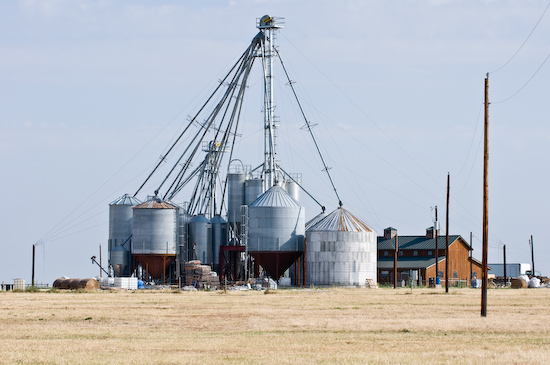
His laying hens eat live grass (in the abnormally high temperatures of this year's summer and low rainfall, the grass has mostly yellowed) to their hearts content, the animal protein that they can catch (worms, grubs, and insects), and organic grain when they choose. This isn't a barn or hen house operation where the chickens are free to roam in the structure (so called cage-free) or a dark enclosed building with a little door to a 6-ft. x 6-ft. dirt patch outside (what most free-range operations are). The hens are out in the open, running around, making chicken noises, with a portable tent and a egg laying area set up on the field. I watched as a couple of the hands that work on the farm hooked up one of these tents to a tractor and pulled it to a new location. The hens eat a healthy mix of animal and vegetable (as they should - vegetarian fed hens are usually malnourished or missing important nutrients which may have to be fortified into their diets) and roam around like chickens are depicted in a children's book. There's no lie here or linguistic trickery - the chickens really are pasture raised.
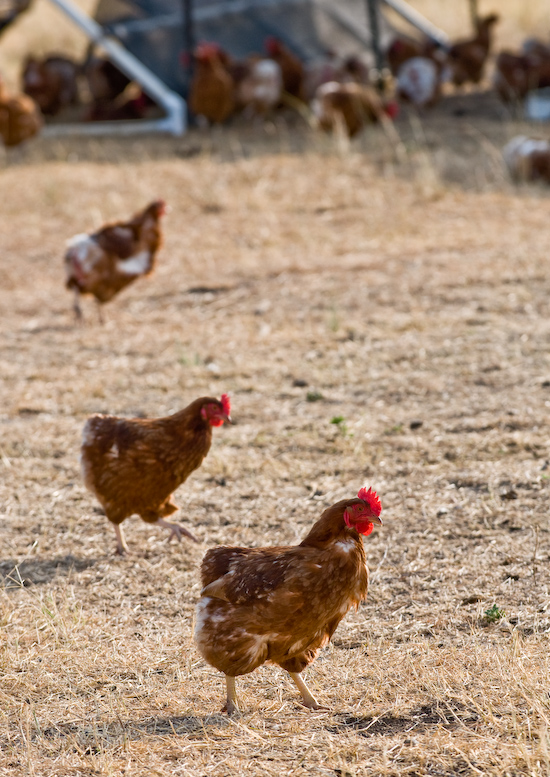
The chickens eat grass, bugs, and grain while in one part of the pasture - cover it with their droppings (chicken droppings are excellent fertilizer) and are moved to the next area. Rain falls, grass grows, and Coyote Creek's cattle eat the grass - consuming a diet their stomachs were intended to digest. Jeremiah's organic grass-fed cattle aren't just there to be eaten. His focus is on breeding. The females, when they come of age, are sold to other farms in need of cows to start or increase their livestock. Again, Coyote Creek's focus is on enabling the local community to be able to farm in a sustainable fashion and to provide natural foods to the community.
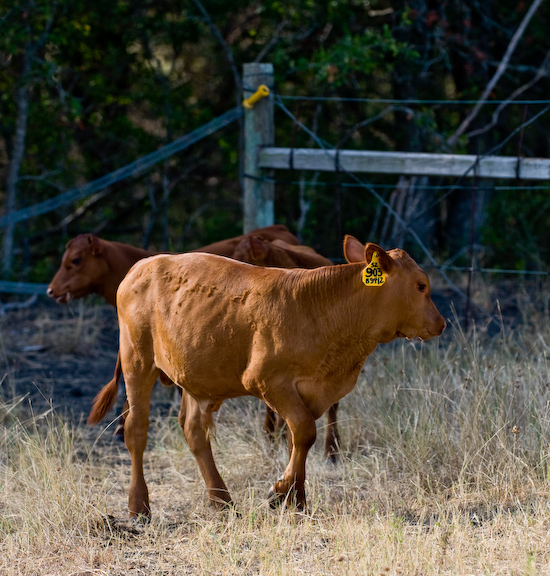
Jeremiah also brews his own compost tea and will gladly teach aspiring farmers (or experienced ones who realize that the long term costs of industrial farming leads to diminishing quality and profits as time goes on) how to brew and manage their own system of microorganisms to replenish, revitalize, and keep healthy the land they depend on without the use of petrochemicals. After staring this 70-something-year old (who walks and talks with more energy and vigor than many 50-year olds) man in the face, shaking his hand, listening to his passion, tasting what he has raised and produced from his land without taking more out of it than he puts in, and enjoying the peace of his farm — how can I not want to support him? For my part, I'll do what little I can and continue to buy his eggs. $5 to $6 a dozen is a small price to pay when the impact of that one carton contributes to so much. Am I ready to buy half a cow from him? Not yet, but maybe once I get a deep freezer.
There is also something incredibly peaceful and almost emotional about being on Jeremiah's farm. You can hear the trees rustling in the breeze, smell the fragrant aroma of animals and drying grass, and feel the warmth of the living ecosystem (half of which is below the surface of the earth). There's more to it than that, but it's hard for me to describe. I found myself smiling and feeling profound peace. While walking the grounds, I truly felt emotionally moved. When we said our good byes, Jeremiah presented us with a couple pounds of his ground beef to try and we immediately began to plan for our dinner.
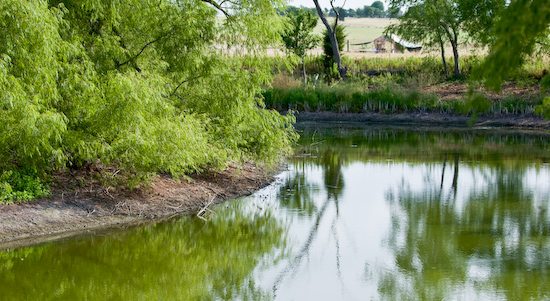
By evening, I had decided on making a Salisbury steak of sorts. I kneaded one pound of the ground beef with one of Jeremiah's eggs, mixed in some aromatics, and pan fried the ground beef patties. From the drippings and the fond stuck in the pan, I fashioned a gravy with some beef broth, black pepper, salt, and ground sage. I served this with a side of local Texas summer squashes (cooked with garlic) and white rice over which I poured the gravy. The beef was tender, flavorful, and delicious. Was it more delicious than other ground beef that I've had? It's hard for me to tell - I haven't developed a palate for grass-fed beef yet, nor have I comparison tasted ground beefs - but, I do know that I don't have to worry about resistant E. coli in this meat (for the cow had never eaten grain which leads to abnormally high acid levels in the rumen which eventually leads to acid resistant E. coli leading to E. coli capable of surviving the acids in human stomachs contaminating the meat leading to the massive ground beef recall of the last few weeks), and I've seen the farm where the steer had been born, the pasture where he dined, and the woods he rested in away from the brutal sun. That makes for a pretty satisfying meal.
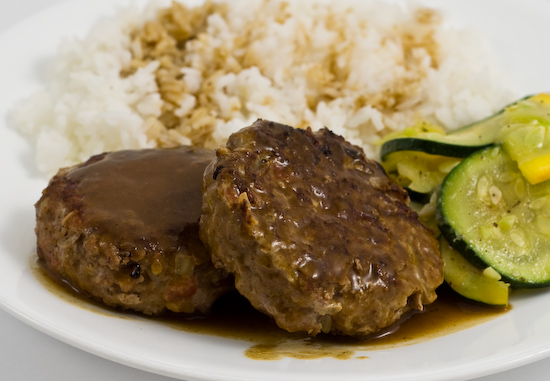
Lunch: After only a few hours of sleep and a whole morning of driving, we were too tired to prepare a "fancy" lunch. So, I boiled some water and cooked two packets of Paldo-brand Kimchi Ramen. We served it with the leftover chicken and red bell pepper stir-fry from the other night and some okra chips.
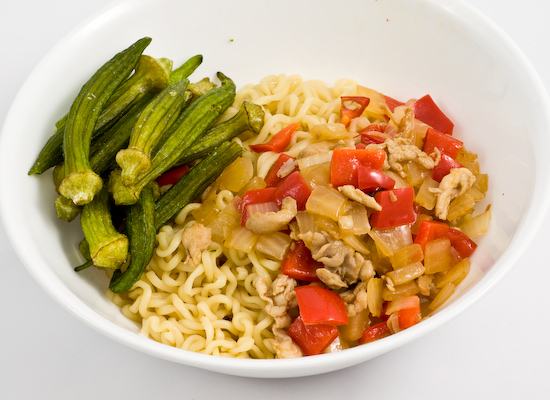
2 comments to What I Ate: July 7, 2009 (Coyote Creek Farm)
Nate, July 7th, 2009 at 11:53 pm:
-
Beautiful pictures. Thanks for taking us along. I hope we can find something like that in Malaysia. Will we be able to afford the food? That remains to be seen.
Michael Chu, July 8th, 2009 at 4:41 am:
-
Is food very expensive in Malaysia? I've never thought about it - I just assumed food was inexpensive in most of Asia (except Japan).